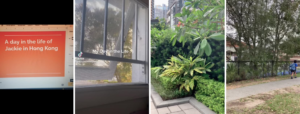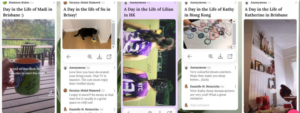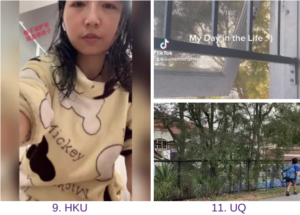A new cross-cultural project has found that “mundane moments matter” when it comes to wellbeing. The ways in which “the mundane matters” have emerged from a pilot study exploring wellbeing and identity involving researchers from Griffith, the University of Hong Kong (HKU) and the University of Queensland (UQ) and students from HKU and UQ.
The pilot project included an activity in which students composed digital artefacts in the form of “Day in the Life” videos. It also incorporated a series of online workshops, cultural tours, well-being surveys, and focus groups for discussion and reflection.
Dr Danielle H. Heinrichs from GIER is on the project team, working alongside Dr Suraiya Hameed, Dr Kate McLay, Dr Huong Nguyen from UQ, and Dr Jack Tsao from HKU. Findings were recently presented by Dr Heinrichs at the Redesigning Pedagogy International Conference hosted by the National Institute of Education at Nanyang Technological University, Singapore.
A recording of her presentation is shown below.
On the project, she says:
“The impetus was a collective concern for students’ wellbeing during the pandemic, particularly for international students. We noticed they were feeling disconnected and lonely, and we had seen the impact on attrition, engagement and motivation. We wanted to help them build a sense of identity and belonging to the university campus through this time.”
The project asked students to film moments throughout an entire day and highlight moments that contributed to their wellbeing. The short videos were then uploaded to Padlet; alongside focus groups and reflections, the “Day in the Life” videos showcased the students’ routines, contingencies, improvisations and accomplishments as examples of wellbeing on an average day.
Dr Heinrichs says:
“We initially planned the ‘Day in the Life’ videos as a pedagogical approach but found the students responded really positively to them and commented on this quite a bit.”
Across the cultural groups, local mobility (e.g. travelling to and from campus) was a source of wellbeing in times of increased immobility. Physical mobility (exercise) was also commonly highlighted as a key source of energy and sanity.
There were also collective concerns for kin, relationality, and unlearning.
On this, Dr Heinrichs says:
“a lot of what the students wanted to engage in was what we would term the ‘opposite’ of academic work, like playing games, watching YouTube videos or using apps. But what we noticed is that the students were still learning things, like languages on Duolingo or how to cook a new recipe. It was about unlearning what learning is. Many students also commented that the digital literacy skills they picked up were something quite new.”
Differences between the groups existed in the capacity for agency, meaning different rules in terms of what they could do in lockdowns, and what was offered on campus for students to be involved.



Dr Heinrichs says:
“The students in Hong Kong were able to get credit for their work on this project, so they were certainly more engaged whereas the Australian students didn’t get credit and participated during exams. Thus, this group required more chasing up. We had a mix of international and domestic students in Australia, and found the international students were generally more involved.”
The project has provided some ideas around how to embed students’ (re)conceptions in pedagogy. On this, Dr Heinrichs says:
“The takeaway is that there is method and theory that can inform our understandings of wellbeing stemming from an activity exploring what is seemingly simple and banal. These include the ‘Day in the Life’ methodology and the concept of ‘mundane data’. It has been great learning for the researchers also, and we are excited to work more with this, perhaps as part of a bigger project.”
On the students’ experiences, she says:
“Students really liked getting insights into each other’s lives. They appreciated the opportunity to see and share personal elements of their lives in their homes, bedrooms or cars which are places we don’t usually see in virtual exchanges. There was also a sense of accomplishment in being able to work on a shared project.”
The team are hoping this will form part of a bigger project incorporating a face-to-face element of the experiences with students to provide them with the opportunity to learn more about why certain mundane moments build wellbeing and belonging.


